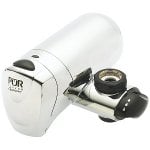As the debate over the benefits and problems associated with use of free chlorine ( EPA Approved test strip for free chlorine ) as a disinfectant in public and private drinking water systems rages on and more people become aware of compounds known as disinfection byproducts, the desire for point-of-use water filtration systems capable of removing disinfection byproducts continues to grow.
|
|
One particular disinfection byproduct of, trihalomethanes (often abbreviated as THM’s or TTHM’s), has gained enough notoriety that companies like PUR have started certifying some of their products to NSF/ANSI Standards for the reduction of trihalomethanes in drinking water.
Below you will find a list of several PUR water filtration products that have tested and certified to NSF/ANSI Standard 53 (Drinking Water Treatment Units – Health Effects) for the reduction of TTHM’s and other unwanted drinking water contaminants:
- PUR CR-6000 Filtered Water Pitcher
- PUR CR-6000C Filtered Water Pitcher with LED Light
- PUR Faucet Mount Filter 3-Stage – Flavor Options
- PUR Faucet Mount Filter 3-Stage Horizontal Chrome
- PUR Faucet Mount Filter System 3-Stage Chrome
- PUR Faucet Mount Filter System 2-Stage White
For those unfamiliar with how trihalomethanes get into drinking water, they get created when free chlorine molecules attack, neutralize and become entangled with a biological contaminant. That process chain of events converts free chlorine into combined chlorine and in the process disinfection byproducts get created.
What harm can trihalomethanes in drinking water cause?
Four different trihalomethanes can form as a result of chlorination: Chloroform, Bromodichloromethane, Dibromochloromethane, and Bromoform. The United States Environmental Protection has found that excessive exposure to these compounds has resulted laboratory rats developing cancer.
While many scientists may disagree on the exactly how much exposure to each compound constitutes overexposure, we think it wise to keep tabs on your local water treatment system’s track record of trihalomethane level management (data available in annual reports) and if deemed necessary, install an NSF certified water treatment system capable of reducing trhalomethane levels.





